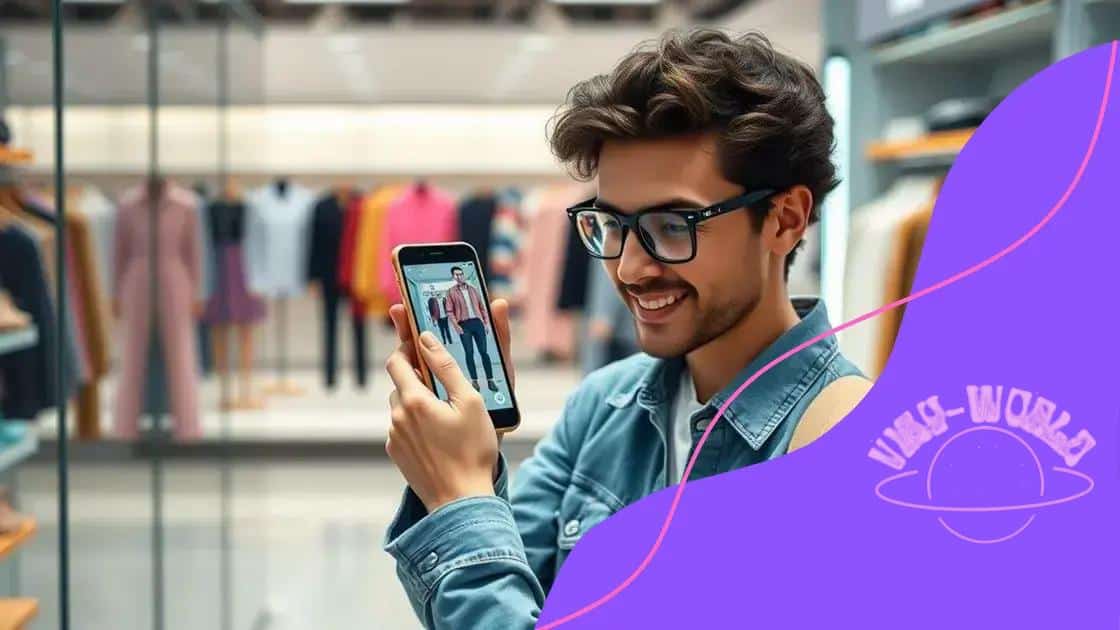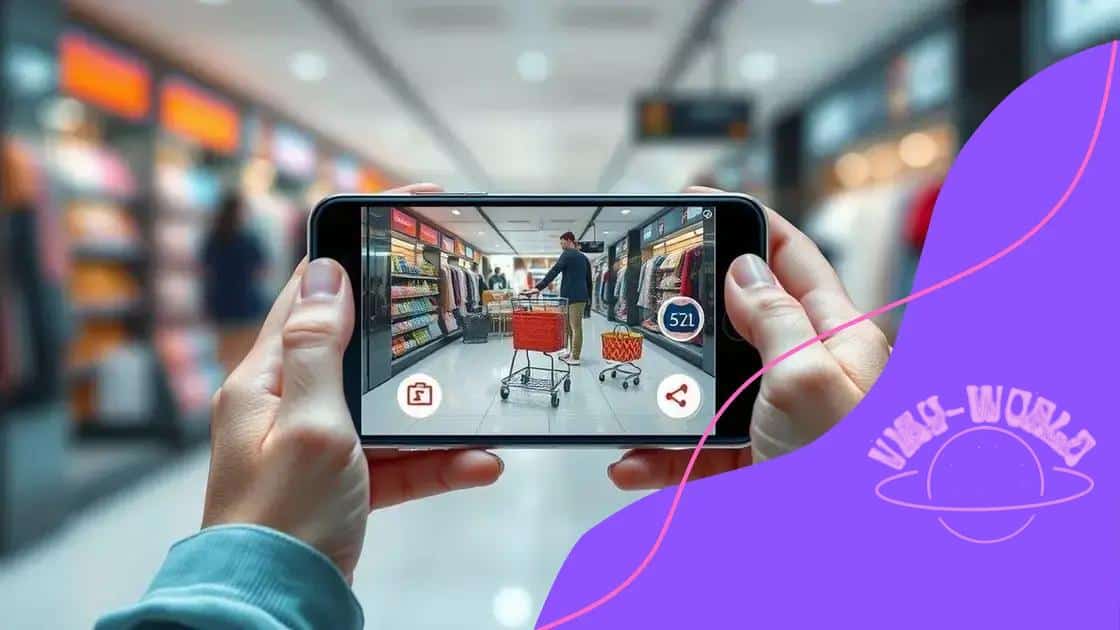Augmented reality enhancing shopping experiences today

Augmented reality enhances shopping by allowing customers to visualize products in their environment, try items virtually, and engage with interactive features, thus improving their overall purchasing experience.
Augmented reality enhancing shopping has become a game changer in the retail landscape. Have you ever imagined trying on clothes virtually before making a purchase? This innovative technology opens doors to immersive interactions that can reshape consumer habits and boost sales.
Understanding augmented reality in retail
In the world of retail, augmented reality (AR) is becoming an exciting trend. By blending the digital and physical worlds, AR offers shopping experiences that captivate consumers. Imagine walking into a store and seeing virtual products that you can interact with. This technology creates an engaging shopping environment that can boost sales and customer satisfaction.
Benefits of Augmented Reality in Retail
Using augmented reality in retail comes with multiple advantages. Retailers can provide unique experiences that keep customers coming back. Here are some benefits:
- Enhanced customer engagement with interactive displays.
- Increased confidence in purchasing decisions through virtual try-ons.
- Personalized shopping experiences tailored to individual preferences.
- Opportunity for brand differentiation in a competitive market.
As consumers increasingly seek convenience and personalization, retailers must adapt. Implementing augmented reality can set a store apart from others, making shopping more fun and interactive. For instance, companies like IKEA use AR to allow customers to visualize furniture in their homes before they buy.
How AR Works in Retail
Understanding how augmented reality functions is essential for retailers looking to implement it. AR technology typically uses a combination of hardware and software. The hardware can be a smartphone, tablet, or specialized glasses, while the software overlays digital images on the real-world view.
When customers point their devices at a product, they can see additional information or visualize the item in a different context. This not only enhances the shopping experience but also provides valuable information that could influence purchase decisions.
In conclusion, as technology evolves, so does the retail industry. Augmented reality is at the forefront of this change, offering retailers innovative ways to engage customers and streamline the shopping process.
How augmented reality enhances customer experience
Augmented reality plays a significant role in enhancing the customer experience in various ways. Through interactive features and innovative applications, retailers can make shopping both enjoyable and informative. Imagine trying on clothes without stepping into a fitting room or visualizing how a piece of furniture fits in your home. These experiences make shopping exciting.
Interactive Shopping Experiences
With augmented reality, customers can engage with products in new ways. They can see virtual items placed in real environments, which helps them understand how something will look or fit. Key features include:
- Virtual try-on for clothing and accessories.
- 3D visualizations of products in the real world.
- Interactive product demonstrations that showcase functionalities.
- Enhanced engagement through gamified shopping experiences.
This kind of interactivity not only captures attention but also retains it. Shoppers are more likely to explore options and make informed decisions when they can see products in action.
Personalization Through Augmented Reality
Personalization is another benefit of augmented reality. Retailers can tailor experiences based on individual customer preferences. For instance, apps can analyze past purchases and recommend products more likely to appeal to specific consumers. This makes customers feel valued and understood.
By utilizing augmented reality in this way, retailers can create a more tailored shopping environment. Customers enjoy a unique experience, making them more likely to return. Imagine a store that knows your style and suggests outfits based on your previous choices.
Furthermore, AR apps can provide additional information about products, helping customers make choices that suit their needs. When consumers have all the details at their fingertips, they feel more confident in their purchases. This ultimately leads to higher satisfaction and loyalty.
The technology behind augmented reality shopping

The technology behind augmented reality shopping combines hardware and software to create immersive experiences. By using this technology, retailers can enhance how customers interact with products. But how exactly does this work?
Key Components of Augmented Reality
There are several critical components that make augmented reality possible. The main elements include:
- Hardware: This includes cameras, sensors, and mobile devices that capture real-world environments.
- Software: Applications that process data and overlay virtual images onto the real-world view.
- Tracking Technology: This detects the position of the user in relation to the environment to place virtual objects accurately.
- Interaction Techniques: Methods that allow users to engage with the virtual elements, such as gestures or voice commands.
These components work together to deliver engaging content. As consumers use their devices to explore a retail space, they can see products in new dimensions.
How Augmented Reality Works
Understanding how augmented reality works is crucial for retailers. When a customer points their device at a certain product, the AR software identifies the item and presents related virtual information. This can include details like sizes, colors, or how the product might look in different settings.
Technology such as GPS and image recognition plays a role in enhancing the shopping experience. GPS helps identify the user’s location, while image recognition detects surfaces or objects, leading to a tailored experience. For example, someone shopping for furniture can visualize how a couch would fit in their living room, creating an informed purchase experience.
This combination of elements not only makes shopping convenient but also interactive. As customers navigate through stores, AR can provide them with tailored recommendations, making the process more engaging.
Case studies of successful AR shopping initiatives
Many brands have successfully implemented augmented reality (AR) in their shopping strategies, transforming how consumers interact with products. These initiatives show the real-world benefits of AR in enhancing customer experience and increasing sales.
IKEA Place
IKEA launched the IKEA Place app, which allows customers to visualize how furniture will look in their homes. Users can point their devices at a space and easily place virtual furniture items in their desired location. This helps customers make decisions before they purchase and reduces the likelihood of returns.
Sephora Virtual Artist
Sephora has taken a step further with its Virtual Artist feature. Shoppers can use their smartphones to apply virtual makeup. They can mix and match products to see how they will look on their skin. This feature boosts customer confidence by allowing them to experiment without commitment.
Warby Parker’s Virtual Try-On
Warby Parker made buying glasses easier with their Virtual Try-On feature. Customers can see how different frames look on their faces through their mobile app. This personalization encourages consumers to feel more connected to their choices.
Nike Fit
Nike launched Nike Fit, an app that uses AR to scan your feet to identify the best shoe size. This technology helps customers find the right fit, improving satisfaction and decreasing return rates.
These case studies demonstrate how augmented reality can create a more engaging and interactive shopping experience. From visualizing furniture placements to trying on makeup or glasses, AR has proven to be a beneficial tool for both customers and retailers.
Future trends in augmented reality for shopping
The future of augmented reality (AR) in shopping looks bright, with many trends shaping how consumers will interact with products. As technology advances, so do the ways retailers can engage customers. We can expect to see some exciting developments in the coming years.
Personalization and AI Integration
One major trend is the increasing use of AI to personalize AR shopping experiences. Retailers will use data to tailor suggestions based on individual preferences. For instance, the AR experience might change based on previous purchases, browsing history, or even customer feedback. This will create a more customized shopping journey, making shoppers feel more valued.
Enhanced Mobile Experiences
The rise of mobile shopping has driven significant improvements in AR applications. Future AR tools will likely become more accessible via smartphones, allowing consumers to use AR anytime and anywhere. Features such as virtual try-ons and product visualizations will become quicker and easier to access.
- Improved camera technology for better AR functionality.
- More intuitive user interfaces for seamless navigation.
- Integration with social media platforms for shared experiences.
These advancements will make it easier for consumers to adopt augmented reality as part of their shopping habits.
Retail Environments and In-Store Experiences
As retailers invest in AR technologies, physical stores will integrate these tools to enhance in-store experiences. Imagine walking into a store where your mobile device helps you find products faster. Store layouts may change to accommodate AR displays that provide instant information about items you encounter.
Shoppers will be able to engage with products dynamically, allowing them to make informed decisions on the spot. Retailers can also leverage AR for interactive advertising, leading to unique promotions tailored to customer behavior during their shopping experience.
As we look ahead, it’s clear that augmented reality will not only change how we shop but also transform retail landscapes. The future promises a blend of technology and creativity that will enhance customer experiences and redefine consumer expectations.
FAQ – Frequently Asked Questions about Augmented Reality in Shopping
How does augmented reality improve the shopping experience?
Augmented reality enhances the shopping experience by allowing customers to visualize products in their environment, try items virtually, and access interactive features that provide additional information.
What are some examples of brands using augmented reality in retail?
Brands like IKEA, Sephora, and Warby Parker use augmented reality to help customers visualize furniture, try on makeup, and find the perfect glasses, respectively.
Will augmented reality become more accessible for mobile users?
Yes, as technology advances, AR applications will become more accessible on mobile devices, enabling customers to use these features anytime and anywhere.
How does AI play a role in augmented reality shopping?
AI helps personalize augmented reality experiences by analyzing customer data to provide tailored recommendations and suggestions based on individual preferences.





